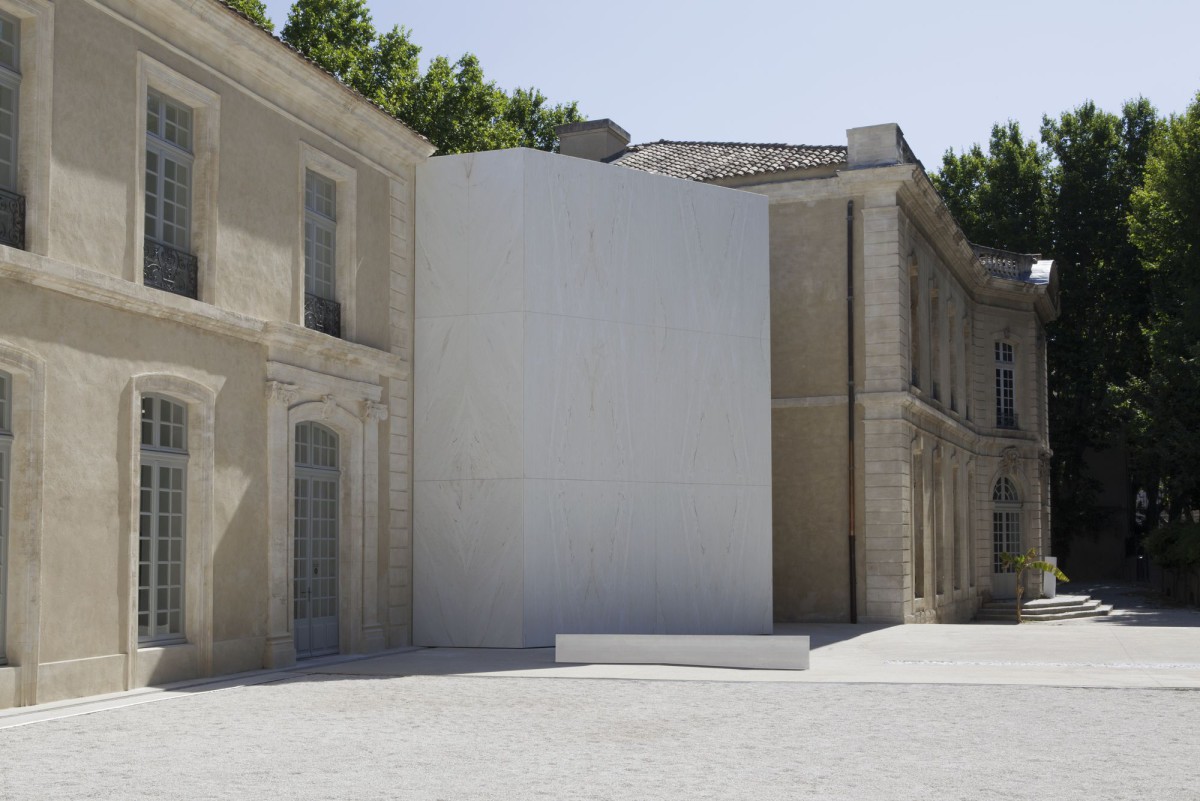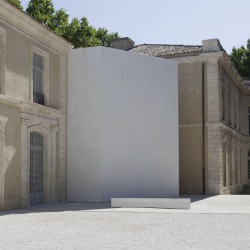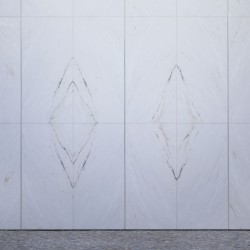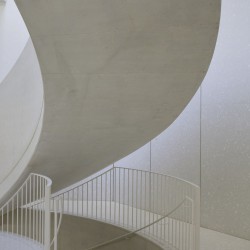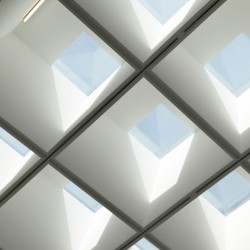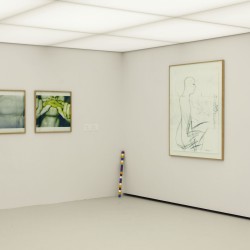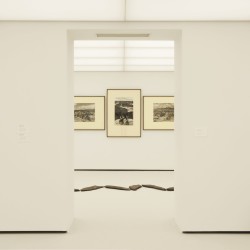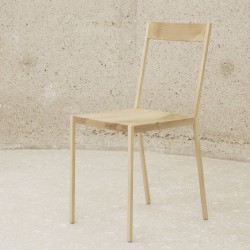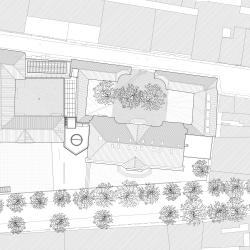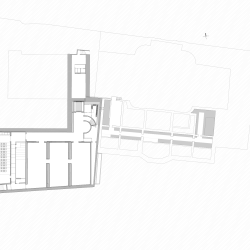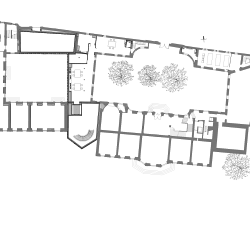Berger&Berger . photos: © Laurent Berger
Composed of the exceptional art works acquired throughout his lifetime by gallery-owner and collector, Yvon Lambert, the Lambert Collection is reopening its doors to the public after two years of renovation work. The collection was first installed in the Hôtel de Caumont in June, 2000, a mansion from the 18th- century. The donation of the Yvon Lambert collection and its entrance into Avignon’s National Heritage Depository were made official in July, 2012. Its 556 works were thus made a part of the inventory of the National Fund of Contemporary Art, making them untransferable and everlasting.
Towards Neutrality in Architecture
The architectural competition to build a new museum was won by Berger&Berger. The museum originally housed in the Hôtel de Caumont was extended to the Hôtel de Montfaucon, thus increasing its surface area two-fold to 6,000 sq. metres. The combined space of the two «Hôtels» into one entity made it possible to exhibit the entire works of the Lambert Collection in one Avignon locale.
The Lambert Collection’s new museum highlights the coherence and advantages of two private mansions by creating links at all levels whilst meeting the climate requirements for preserving art works. Three new buildings were also created, the first being an atrium acting as a pivot between the two mansions so as to join them together; the second being located between the two historical courtyards; and the third being an enclosure of the Montfaucon courtyard housing a single grand exhibition room, called «the high-ceiling room». The outer walls of these new buildings show no piercing compared to the two historical 18th-century buildings. The project joined geometric spaces and varying atmospheres. Works are exhibited in spaces that meet lighting and hygrometric requirements, alternating or blending artificial with controlled natural lighting. The ensemble includes spacious galleries infused with natural light from the historical architecture and artificially-lit abstract galleries that correspond more to the «white cube» of big modern museums. The exhibition rooms compose multiple «landscapes» created with the same tools, i.e. whiteness, light and volumes. Some of the new exhibition rooms have been custom built for works in the Collection that could not be shown in the old museum because of its limited space. The museum’s numerous galleries provide a variety of atmospheres and spatial qualities that make it possible to exhibit a varied range of works such as videos, photographs, sculptures, installations and paintings.
The public still enters the collection through the courtyard of the Hôtel de Caumont. It embodies and identifies the museum every bit as much as the preserved entrance hall with its staircase listed as an «historical monument».
There are three rooms in a row on the ground floor of the Hôtel Montfaucon with those of the Hôtel Caumont. The original windows provide natural light combined with even and regularly distributed artificial light using intensity-adjustable LED lights in the ceiling.
Works in the courtyard of the Hôtel de Montfaucon can be seen from these galleries, making the courtyard a genuine open-air exhibition room in its own right.
The outer walls of the two original mansions face two marble rails attached to the walls of the
new buildings like an abstract white background against which the exhibited works stand out. They redefine the courtyard as a central element around which the mansion’s galleries are organised. The white of the marble reflects the sunlight which is spread through the galleries on the ground and first floors. It is direct daylight.
A new, high-ceiling room has been built on the rue Violette, creating 5.5 metres of free space that makes it possible to exhibit the largest of the collection’s works, which until now couldn’t be put on show in the Hôtel de Caumont. This room’s coffered ceiling makes it possible to light this space and the coffer’s walls by reflecting the natural light
that enters through an opening created in the upper part of the coffer. Natural and artificial light blend together. Direct natural light cannot reach the floor or the walls in this room thus protecting the works on display. It is possible to close the coffers’ shutters and throw the room into total darkness. A set of horizontal steel rails set into the concrete and arranged behind gypsum boards make it possible to carry heavy loads for hanging works.
On the first floor a new continuous L-shaped gallery measures about 400 sq. metres, nearly twice as long as the gallery on the first floor of the Hôtel de Caumont and is an extension of it. These two galleries provide about 700 sq. metres of exhibition space revolving around the atrium. The supporting walls were removed and replaced by concrete porticos. As on the ground floor, the lighting is a blend of natural and adjustable artificial light.
Hôtel de Montfaucon’s basement contains three large rooms that are artificially lit by a diffuse
light, the intensity of which is adjustable, enhancing drawings and photographic works from 0 to 300 Lux. The light is diffused through a double-layered fabric ceiling with the higher layer catching impurities. The basement gallery is artificially lit with fluorescent light.
Hôtel de Montfaucon’s auditorium has been preserved but redimensioned. Brought up to standard, it has been reshaped so as to improve the audience’s view of lectures, film screenings and video works. A dark colour (RAL ultra-marine) has been applied to all items and surfaces in this space (concrete blocks, metal desks, wooden armchairs, etc.). Only the chrome in the restored auditorium armchairs was not painted. An acoustic curtain can be lowered along
the auditorium’s four walls and is adjustable so as to enable several different acoustic effects.
And lastly the atrium – like a hinge and socket – has become a new access point to the building, making it possible to receive even the largest works directly from Boulevard Raspail, then take them to the new lift serving the various exhibition levels or towards the museum’s newly- added restoration rooms. This atrium joins the two hotels and has been done entirely in white concrete with prefabricated, polished walls made of white marble aggregate, thus linking it to the raw quality of the concrete (also white), the floors and the stairway that was poured in place. A large oculus (4 metres in diameter) is the only opening by which natural light can enter. The artificial light is neon. The floor of the ground floor and the walkway connecting the Hôtel de Caumont to the Hôtel de Montfaucon is in Terrazzo exactly like the prefabricated concrete shear walls that are also composed of the same white-marble aggregate. Like the walls, the floors are white (light grey) and create a space shared by visitors and works bereft of their pedestals. The architectural surfaces themselves diffuse the light, making it possible to avoid practically all use of spotlighting.
White is not the sign of an architectural style here, more the objective, physical quality for eflecting light. This neutral architecture, using simple geometric shapes, makes the museum a «mineral setting» defined by its reflective levels.
Extention and rehabilitation of Collection Lambert in Avignon.
Client :
Citadis – Ville d’Avignon
Architectes :
Berger&Berger : Laurent P. Berger, plasticien Ensad et Cyrille
Berger, architecte dplg.
Collaborateurs : Nina Baniahmad, Luke Gleeson (chef de projet
chantier), Théo Vachon, Jean-Benoit Vétillard (chef de projet
études)
Christine Schmückle-Mollard, Acmh, achitecte associée.
Engineering firms
Bollinger + Grohmann (structure)
INEX (fluids)
VPEAS (economy)
Reflexion AG Zurich (light engineering)
Ducks sceno (scenography)
J-P. Lamoureux (acoustics)
Casso et associés (SSI, accessibility)
Pierre Duclaux (OPC)
Calendar
Competition : juillet – octobre 2012
Studies : novembre 2012 – août 2013
Construction : janvier 2014 – juin 2015
Delivery : juillet 2015
Photographies : Berger&Berger

